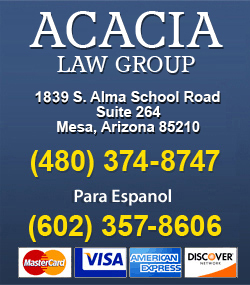Suite 264
Mesa, Arizona 85210
(480) 374-8747
(602) 357-8606 (espanol)
Suite 312
Tucson, AZ 85701
(520) 468-6668
(602) 357-8606(espanol)
(The content below was transcribed from an interview done with Acacia Law. We think you'll find it much easier
and more enjoyable to read this way.)
Acacia Law It's rare that it's rocks or bricks. More common are people carrying some kind of concealed weapon, either for self-defense or for offensive purposes. These are the types of instruments that come into play in street fights. These are the types of instruments that can cause severe damage and death to an individual who is on the receiving end. Those are the most common instances that I see these types of aggravated assault.
Interviewer: So, if two people are in a bar fight or in a street fight, and the police come what are they going to be charged with and what are they going to face?
Misdemeanor and Aggravated Assault
Acacia Law It depends on the nature of the injury. Let's assume for example that you have two individuals engaged in a simple street fight using fists. Now, assuming that no one is severely injured or permanently disfigure, then it is going to be a class one-misdemeanor assault. Normally that is in fact what occurs. However, even if there is no deadly weapon use involved, and it's strictly fists, but one person or the other is severely injured that becomes what's called an aggravated assault.
Dangerous Offense
Depending on the circumstance an aggravated assault is considered a dangerous offense under the criminal code. The danger in being charged as such, and it's a separate allegation by the way, is that it requires mandatory prison time. Also, the sentencing range for dangerous crimes, which involve deadly weapons, is increased substantially from what are called the non-dangerous, non-repetitive offenses, under the code.
Interviewer: So, a dangerous offense is different from an aggravated assault or an assault.
Acacia Law Yes. What happens is the state has to make a specific allegation of dangerousness. So, how that works is as follows. Let's say that I assault somebody with a whiskey glass, as I gave in my previous example, and I hit him or her in the face with it.
Serious Imminent Physical Harm
Whether they're severely injured or not, the state is going to file a separate allegation, which is called an “allegation of dangerousness”. It's based on the fact that a deadly weapon was used, threatened, or exhibited, in such a fashion that a reasonable person would believe that they were in serious imminent physical harm or in danger of serious physical injury or facing impending death.
That charge is separate from the weapon charge itself, and it's added every single time. This is because the jury has to make a separate finding, that the act was in fact dangerous. But since any act that involves a dangerous weapon is considered dangerous, it's pretty much a given that that is what they will find as fact.
Probation and Jail Sentences
Interviewer: So it's a way for the state to stack on extra charges, and it's like a back door for them to double up the charges without doubling the offense.
Acacia Law Correct. As a matter of fact, it's one of the most powerful leverage tools that the state incorporates. The reason is because in a non-dangerous, non-repetitive offense, probation is ordinarily ordered for the individual.
If an allegation is made that the offense is dangerous, the person must be sentenced to prison. There is no alternative. So many of these cases live or fall on the treatment of the allegation of dangerousness. If it's dropped than the person can be probation eligible. If it's left in a plea agreement, the court must send the person to prison. So in it of itself, it is absolutely critical and it is a very powerful tool in the hands of the state. However, there are defenses.


